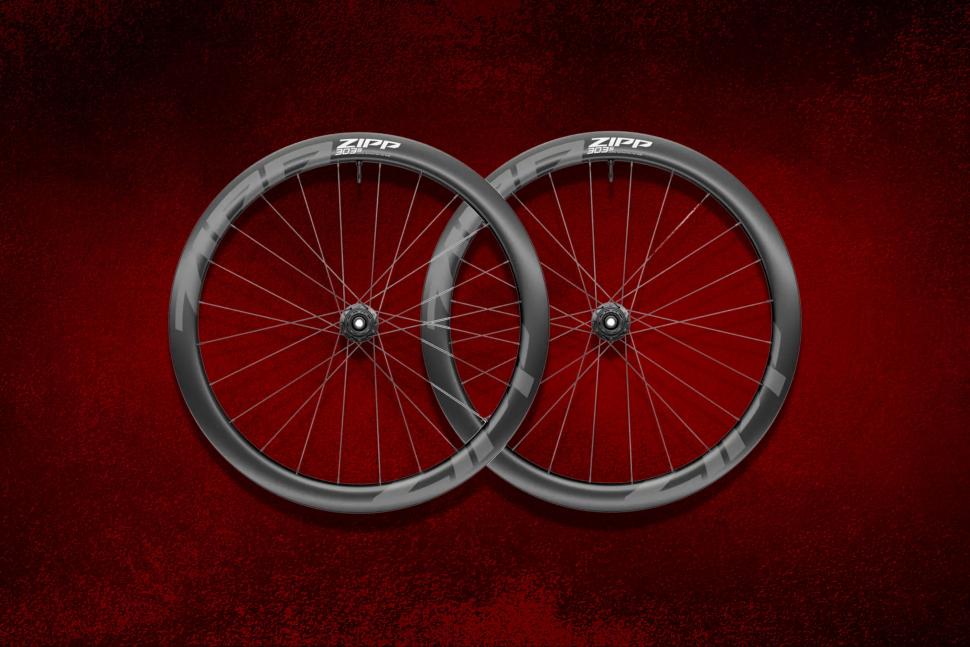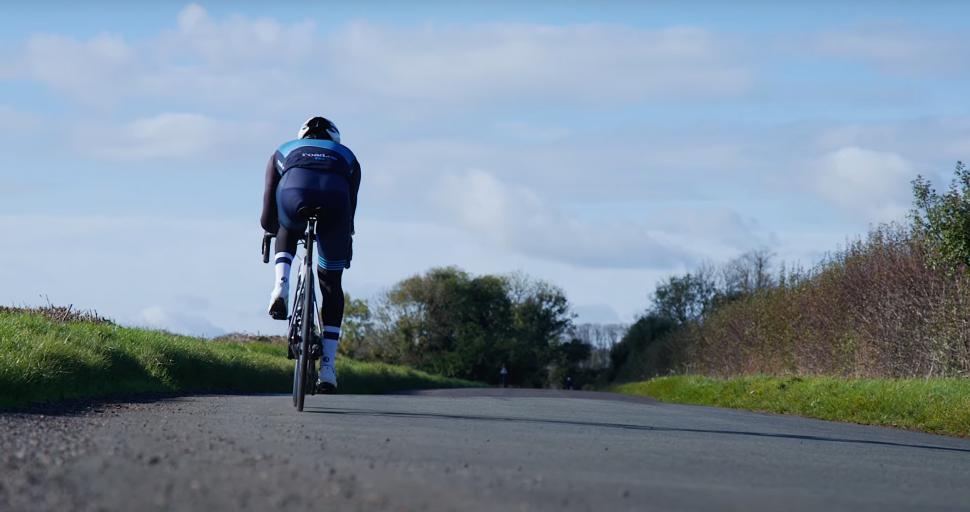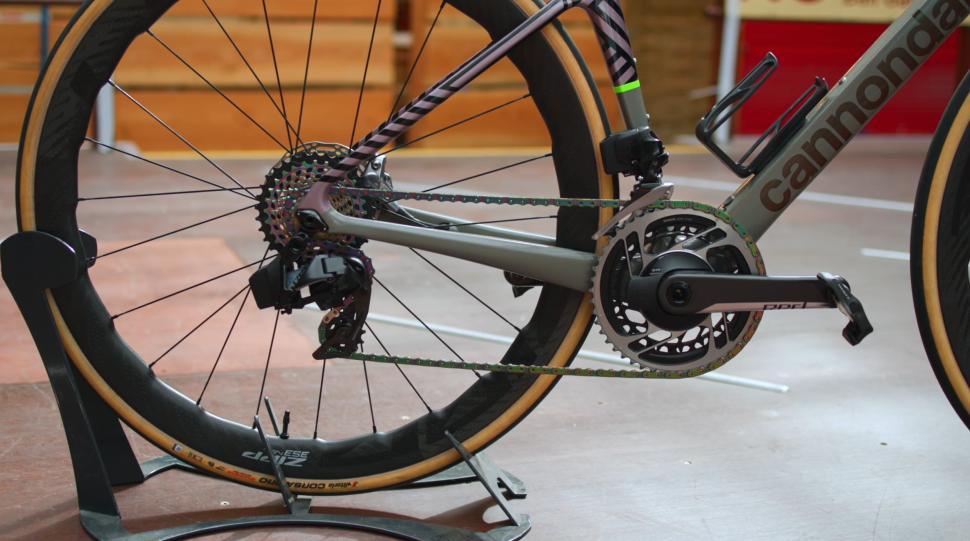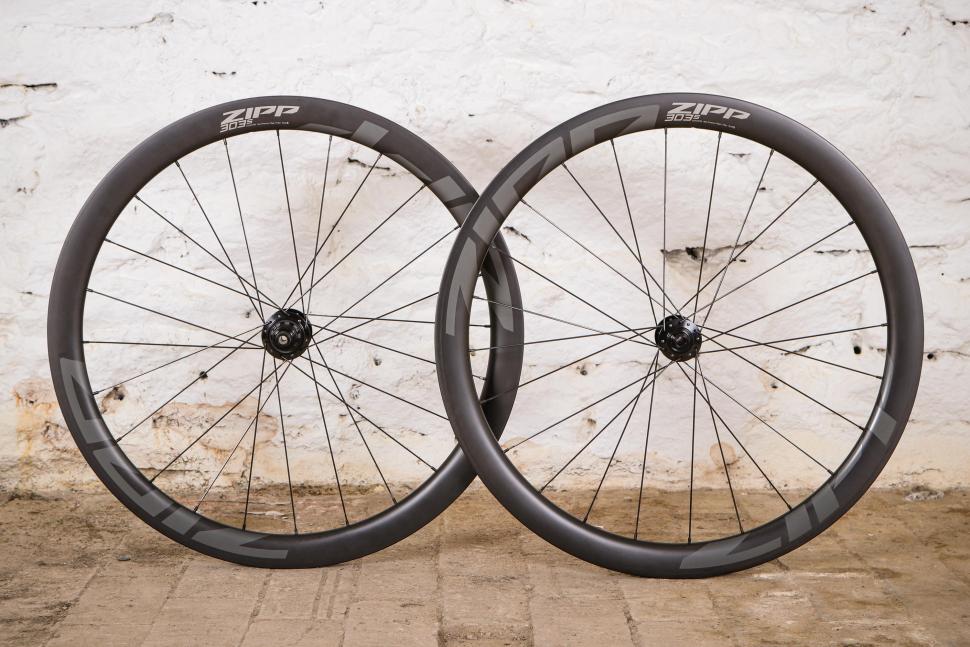- News
- Reviews
- Bikes
- Accessories
- Accessories - misc
- Computer mounts
- Bags
- Bar ends
- Bike bags & cases
- Bottle cages
- Bottles
- Cameras
- Car racks
- Child seats
- Computers
- Glasses
- GPS units
- Helmets
- Lights - front
- Lights - rear
- Lights - sets
- Locks
- Mirrors
- Mudguards
- Racks
- Pumps & CO2 inflators
- Puncture kits
- Reflectives
- Smart watches
- Stands and racks
- Trailers
- Clothing
- Components
- Bar tape & grips
- Bottom brackets
- Brake & gear cables
- Brake & STI levers
- Brake pads & spares
- Brakes
- Cassettes & freewheels
- Chains
- Chainsets & chainrings
- Derailleurs - front
- Derailleurs - rear
- Forks
- Gear levers & shifters
- Groupsets
- Handlebars & extensions
- Headsets
- Hubs
- Inner tubes
- Pedals
- Quick releases & skewers
- Saddles
- Seatposts
- Stems
- Wheels
- Tyres
- Health, fitness and nutrition
- Tools and workshop
- Miscellaneous
- Buyers Guides
- Features
- Forum
- Recommends
- Podcast
TECH NEWS
 2022 Zipp 353 NSW Tubeless Disc brake wheelset - rim 1.jpg
2022 Zipp 353 NSW Tubeless Disc brake wheelset - rim 1.jpgIn conversation with Zipp about hookless wheels: are 28mm tyres ok on 25mm hookless rims, and why are the rules for pros different?
Off the back of two high-profile incidents in the pro peloton where riders had unexpected crashes due to freak tyre blowouts while using hookless wheels, questions were raised over the safety of hookless, with the Professional Cyclists’ Association (Cyclistes Professionnels Associés) saying it was “not happy” with the system. The brands who produce the wheels and tyres involved in both incidents - Zipp and Vittoria, respectively - both insist their products are safe, despite the wheel and tyre combination used (28mm-wide tyres run on 25mm internal width hookless rims) falling short of the 29mm minimum tyre width required for a rim of this width in the UCI's regulations.
When we last reported that Zipp had "reaffirmed" the safety its wheels, a number of readers raised questions about what this means to you as consumers, and also to retailers selling Zipp wheels. Some were concerned about the conflicting information on Zipp's online compatibility charts and the regulations that professional teams have to abide by. The UCI "imposes compliance with International Organisation for Standardisation (ISO) standards", and ISO guidance updated in the summer of 2023 states that 25mm-wide rims should only be used with tyres of 29mm or wider.
> What’s the difference between hooked and hookless bike wheels?
So, is it safe to keep riding narrower than 29mm tyres on wheels that have an internal diameter of 25mm, despite the ISO standard suggesting otherwise? We sat down with Zipp's product managers David Morse and Nathan Schickel to ask them just that, and also hear about the brand's wider approach to testing the quality of its wheels.
What tyre width should you run on your Zipp hookless wheels, then?
We pointed out in our previous article following the hookless wheel failures in the pro peloton that while Zipp's recommendation for pro riders is to use tyres no narrower than 29mm, the compatibility chart on the brand's website continues to say you could go with narrower tyre options.
Morse and Shickel are quick to point out that the recommendation for the pro riders to move to 29mm tyres was done "in order to allow our riders to abide by the UCI regulations to the letter when using the 303 Firecrest or 353 NSW wheels."
They added that there is "not a safety issue with 28mm tyres on 303 Firecrest and 353 NSW" and that it has "four years of riders using 28mm tyres on 25mm rims with success"; meaning that until it seems there is a reason to change the compatibility chart, it will remain as it stands for consumers.
So, should you worry if you have Zipp's 303 Firecrest or 353 NSW wheels wrapped in 28mm tyres? The short answer, according to Zipp, is no. The brand insists that it takes the quality of its rims seriously and that unless it finds a need to update the charts, it won't be rushing to do so: "We want to make sure everything is correctly placed before we make a change or if we make a change", we were told.
Morse also says that Zipp has not had any indication that there is anything wrong with the current recommendations or products.
"We have a pretty good pulse on how our product is performing out in the field. We incentivise every Zipp rider to report problems to us and this is implied through our lifetime warranty. If someone has a problem with their wheels, we want them to come and tell us.
"When [we say] we have very few reported issues with tyre retention, we mean single-digit numbers coming back to us. The last time I checked was earlier this month – I won't tell you the exact number of wheels that we have out in the field, but it is an enormous number – and we're not hearing very many reports. Furthermore, every time we do get a report of tyre retention issues, we ask for that wheel back, and we analyse it and take measurements on it to make sure that it still meets the ISO dimensional spec.
"And so far, 100% of these wheels that have had reported issues have come back and measured within ISO spec. So just rest assured that we are doing our due diligence, we do not see an issue and actually, the reported rate of tyre retention issues on our hookless wheels is just slightly less than the reported rate on our hooked wheels from 2019 and prior, so we feel fairly safe in recommending the original tyre fitment compatibility. The change recommendation to our UCI WorldTour teams is simply to allow them to abide by the UCI rules so that they can continue racing,"
Morse says that if you happen to race at UCI-sanctioned races, then you "should abide by" the 29mm tyre width rule, and though it might appear somewhat contradictory when Zipp insists it does comply with ISO standards, the brand is still happy to recommend the use of 28mm tyres on its wider hookless rims.
Morse adds: "We have four years of history of riders using 28mm tyres on our 25mm internal rims. While we see some tyre fitment issues there, it's not a large number at all. And so we feel that if you're using 28 on a 25 successfully, feel free to continue to use that."
How does Zipp test its wheels, and do the pros get special treatment?
Considering that there are now different recommendations for pro racing compared with the general public, it's perhaps not totally silly to assume that some of the products the pros use are slightly different from what you and I buy from the bike shop. After all, it used to be common for pros to have access to different frames compared to replicas available to the public.
WorldTour racing conditions and the way bike racing works in the event of a mechanical, where often riders will try to keep moving forward until a replacement bike or part arrives, are far removed from the everyday cycling most of us do. Still, the standardisation of things means that most of the equipment pros use is now identical to what's available to the rest of us.
"Take a step back into previous years – I mean, five years or more ago – we had specific carbon laminates for the pros, and we had specific wheel builds for the pros," says Schickel.
"We no longer have that. Instead of mixing hubsets with different models of wheels, as we do within our consumer line, we use a single hubset. That eases compatibility with brake rotor location and cassette location.
"Every professional wheel is laced with the same spokes but uses a brass nipple, just because with all of the washing that those wheels see, alloy nipples tend to corrode and then the wheels can't be true. So we use a brass nipple versus an alloy nipple.
"Other than that, it is as a consumer wheel would be, and then from a testing perspective, you don't test differently for professional wheels than we do consumer wheels."
And what about wheel testing?
After the two hookless wheel incidents at the UAE Tour and Strade Bianche, Zipp took the affected NSW 353 wheels to its own labs for extra tests, and essentially concluded that in both cases, the wheels "had impacts that were very, very large and caused damage to the rim that eventually caused the tyre to come off of the rim".
In a video call, Zipp showed us a Eurosport clip from the UAE Tour stage where one of the incidents happened. That clip shows a rock that was hit by Lotto–Dstny rider Thomas De Gendt. After the impact, what is assumed to be part of his wheel rim flies up in the air.
It's not a scenario any rider would like to experience, and so we asked how Zipp ensures it doesn't. As a side note, we were told it's not entirely down to the hookless rim manufacturer to ensure the overall safety of your setup.
Shickel says: "When it comes to testing, Zipp ensures that they go beyond the standard ISO 4210 test requirements in their internal testing. These tests are done for all wheels, regardless of whether they are going to the professionals or recreational cyclists.
"We see ISO 4210 as the baseline. So that's something that all of our product easily meets all the time, and then beyond that, we use Zipp's 30-year history of making carbon fibre wheels, and we have tests that go beyond that, whether it's for impact, whether it's for rolling durability, whether it's for inflation or tyre retention."
Though Zipp does tests in-house for tyre compatibility, it is the responsibility of the tyre companies to make sure that their products comply with ISO and ERTRO (European Tyre & Rim Technical Organisation) standards too.
"Internally, when we test tyres – and this is a stance that we've had since we started with hookless – is that according to ISO and according to ETRTO, tyre retention is the responsibility of the tyre manufacturer," Shickel says.
"We make sure our wheels meet ISO dimensional regulations all the time and feel like tyre retention and tyre compatibility should be informed by the tyre manufacturer, not by us."
That means that though Zipp has tyre-specific compatibility charts on its website – where you can find the recommended tyre widths for each of the brand's rims – it hopes that the need for those charts would disappear if the industry as a whole followed the same up-to-date standardisation on tyres and wheels.
Shickel adds: "That's a different viewpoint from other hookless manufacturers and it sets us apart, but our stance is to be able to drive to a level of standardisation, eventually, where a rider can go into a shop, buy a tubeless tyre, and it's compatible and everybody has a good day, right?
"Unfortunately, right now we're still in a period of adaptation and a period of the industry catching up to hookless technology, and so there's a need for compatibility charts."
How do you make sure your wheels and tyres are safe?
Regardless of which brand of hookless rims you might have, it's worth keeping a few things in mind before you head out on the roads. The ISO standard saying you should not inflate your tyres higher than 72.5psi is there for a reason, and though Zipp said there is a margin of error in this, it's best to be as accurate with your tyre pressures as possible.
If you're unsure of the recommendations, then you can always reach out to the brand and ask for clarification on compatibility and pressures.
Ever since Thomas De Gendt's tyre went pop, the fiasco has highlighted a slightly chaotic situation between what bike wheel and tyre manufacturers claim is safe, technical standards, and the UCI's regulations.
When it comes to rim and tyre width recommendations on hookless wheels, there is now a discrepancy between what is recommended as safe for the general public and what is recommended for competitive cyclists riding in UCI-sanctioned events, which is bound to cause confusion and uncertainty. While there is still a "period of adaptation" that is yet to be resolved, for now Zipp insists you're good to go with a wide range of 28mm tyres on your 25mm-wide, hookless Zipp wheels outside of UCI-sanctioned events.
Suvi joined F-At in 2022, first writing for off-road.cc. She's since joined the tech hub, and contributes to all of the sites covering tech news, features, reviews and women's cycling content. Lover of long-distance cycling, Suvi is easily convinced to join any rides and events that cover over 100km, and ideally, plenty of cake and coffee stops.
Latest Comments
- chrisonabike 0 sec ago
Sadly, even you fix it so none of us "drive like tw4ts" we would still need separate infra for different modes (cars and trains don't mix, nor...
- Ride On 18 min 36 sec ago
I ended up using Parcelforce - paying online and printing off a sticker - then drop off at the post office. I came across a couple of things worth...
- Rendel Harris 25 min ago
Reckless doesn't exist as a charge in the UK, it's either careless or dangerous.
- chrisonabike 35 min 1 sec ago
Australia?...
- mattw 48 min 12 sec ago
First Degree Assault in Maryland is serious - intent to cause serious injury, regardless of whether injury caused. A firearm makes it First Degree...
- Rendel Harris 56 min 43 sec ago
Beat me to it. 30mph on gravel for a 75kg rider requires around 680W, so those who can achieve it will be experiencing a 0.4% improvement. I know...
- mattw 1 hour 7 min ago
Good comments on the story in the Sheffield Star.
- ktache 1 hour 34 min ago
The madman Fox failed to fill in the form correctly...
- Surreyrider 1 hour 52 min ago
Not so long ago you could get Muc Off for £12 in one of the many sales - £30 is off the scale ridiculous greedflation in action.






Add new comment
4 comments
Assuming we're happy to believe them (and if not why even read the article), the key takeaway seems to be "...we do not see an issue and actually, the reported rate of tyre retention issues on our hookless wheels is just slightly less than the reported rate on our hooked wheels from 2019 and prior..."
Conclusion: If you want to simplify tyre maintenance tasks, stick to hooked rims and inner tubes. I'm a pro' bike mechanic, and I wouldn't choose to mess with tubeless or hookless on my own bike - give me the simple life.
I have no problem with tubeless, I've been a happy user for years, but I don't see what benefits hookless is supposed to bring except lowering the manufacturing costs for Zipp, et al.
That's not a bad thing in itself but when you can get good quality hooked rims at a reasonable price already why bother with something that limits your tyre choice?
My bet is that all these tires popping off are from people with bad pressure gauges or they're simply just putting too much air in on purpose. There's also the likelihood of bad copies of tires being 1mm too big. Unfortunately, it happens with any mass produced product.
*Installing thousands of tires as a mechanic, I have had to use 2 layers of thick cotton tape to get tires to seat on hooked rims. I've also had extremely tight beads with the thinnest tape wind of breaking on bike rides(I'm definitely a low pressure guy too). The tolerances of hookless tubeless is outstanding compared to the train wreck of standard clinchers from the mid range and lower.